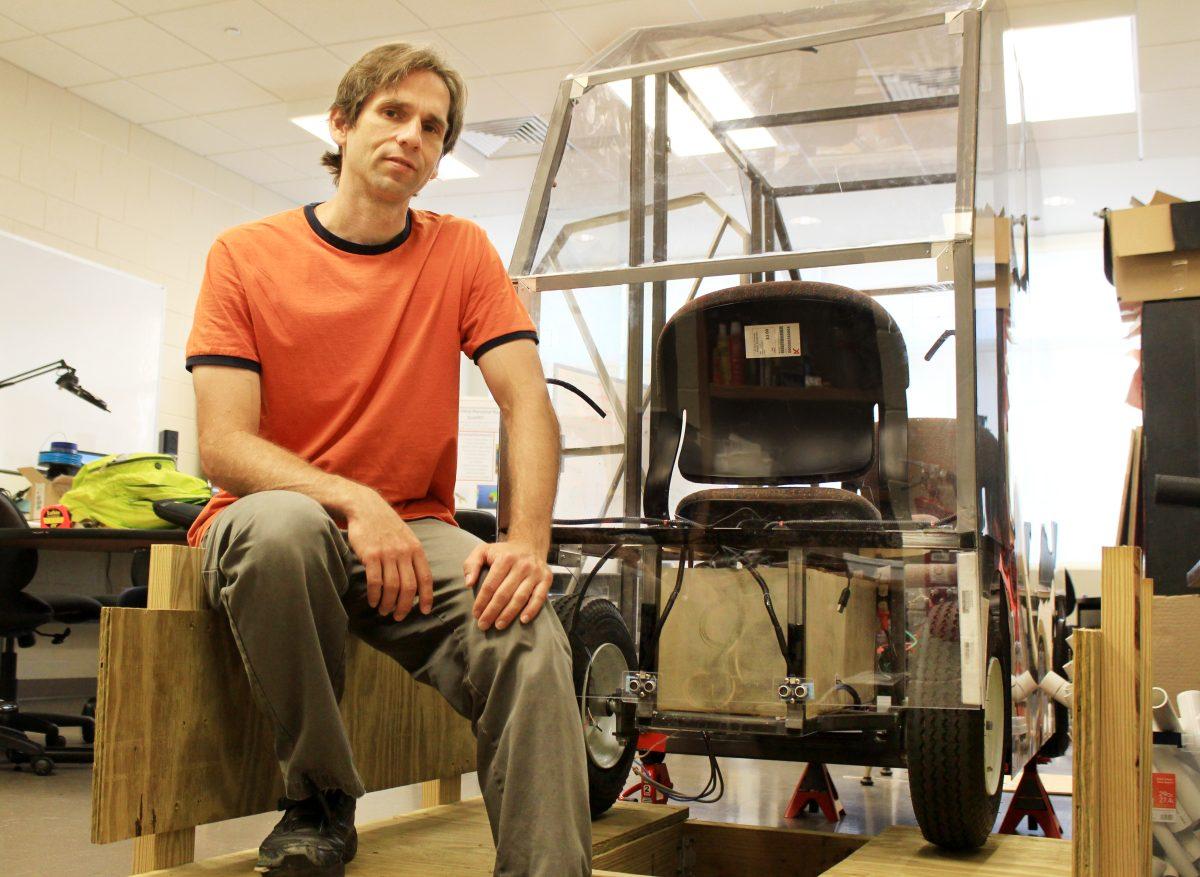 Seth Hollar, associate director of the Engineering Entrepreneurs Program at NC State and co-visionary behind the EcoPRT rail system, envisions that automated fiberglass cars will be used to transport people between Centennial and Main Campus in the future. “It will solve the problem of focusing on extremely small and lightweight vehicles, so if you need to build infrastructure, for example bridges, its lightweight and small form factor make it much less expensive than traditional solutions to move people around,” Hollar said. " />
Seth Hollar, associate director of the Engineering Entrepreneurs Program at NC State and co-visionary behind the EcoPRT rail system, envisions that automated fiberglass cars will be used to transport people between Centennial and Main Campus in the future. “It will solve the problem of focusing on extremely small and lightweight vehicles, so if you need to build infrastructure, for example bridges, its lightweight and small form factor make it much less expensive than traditional solutions to move people around,” Hollar said. " />
Photo by Abhilasha Jain
Seth Hollar, associate director of the Engineering Entrepreneurs Program at NC State and co-visionary behind the EcoPRT rail system, envisions that automated fiberglass cars will be used to transport people between Centennial and Main Campus in the future. “It will solve the problem of focusing on extremely small and lightweight vehicles, so if you need to build infrastructure, for example bridges, its lightweight and small form factor make it much less expensive than traditional solutions to move people around,” Hollar said.
Two NC State professors are on track to create a rail system, EcoPRT, which will offer efficient transportation around campus.
Seth Hollar, assistant professor in the Department of Mechanical and Aerospace Engineering, and Marshall Brain, director of the NC State Engineering Entrepreneurs Program have been working for years now on EcoPRT. A prototype car was recently made, and construction for the test track begins this week.
These cars run on elevated tracks funded by whoever is requesting to build the track. The car will cost $10,000 per vehicle and the track will cost $1 million per mile, both fractions of what subways and buses cost.
“The bus system on campus costs maybe $5 million, $6 million,” Hollar said.
Subway tracks can cost more than $100 million.
“It’s free for NC State students within campus, but maybe if they want to go somewhere else, they pay,” Hollar said.
Off-campus travel will cost 50 cents per mile, but their first big on-campus goal is connecting D.H. Hill and Hunt Library to each other.
“Right now if you try to get between the two libraries on the bus, and you don’t include the wait time, it’s like an 18-minute-average ride,” Brain said. “We’d like to get that down to three or four minutes with no wait time ever.”
The foundation for bridging this gap had been laid out decades prior.
“There’s actually a master plan that has a transit route on it that’s been preserved since the 1990s,” Hollar said. “The original intent was a monorail solution, but because of cost, that never became a reality.”
There are two main differences between EcoPRT and other rail systems: its cost and its efficiency.
The future plan is to extend the rail system to off-campus locations such as Cameron Village and Glenwood South. Heavily populated areas such as airports and shopping malls will be key targets of business due to their already large parking decks and lots.
“It makes a lot of sense to leverage existing parking structures to have stations in some areas,” Hollar said. “There you offload the burden of actually having to build stations yourself and further reducing the costs.”
Both being professors of the Engineering Entrepreneurs Program, they also get help from their students on the project.
“We’ve got over 50 [students] throughout the years to work on it,” Hollar said. “Over the summer we have maybe six or seven.”
Students have been working on the project by designing the test track and getting the GPS to work on the cars.
All students will also be able to test out the EcoPRT themselves soon. In addition to being on-rails, it will be able to drive itself freely on the ground to designated stations marked by tape at the three engineering buildings, the library and the residence halls.
“Getting it running out on that Oval area is going to be kind of the first public demonstration,” Brain said. “We hope to have a little app that goes with that, and a person can stand in front of the library and push a button, and the car will come around and pick them up and then take them. We sort of make an assumption that everybody who’s riding it will have a smartphone.”
Brain believes the EcoPRT will make Raleigh “the city of the future.” It will be the centerpiece that will set NC State and the city of Raleigh apart from the rest. Due to this and the rise of driverless cars, he says, “In 10 years, 20 at the most, human beings won’t be driving cars anymore.”
Brain says the best support for now is simply being aware of the project. They are deciding not to turn to funding services such as Kickstarter. More information can be found on ecoprt.com.